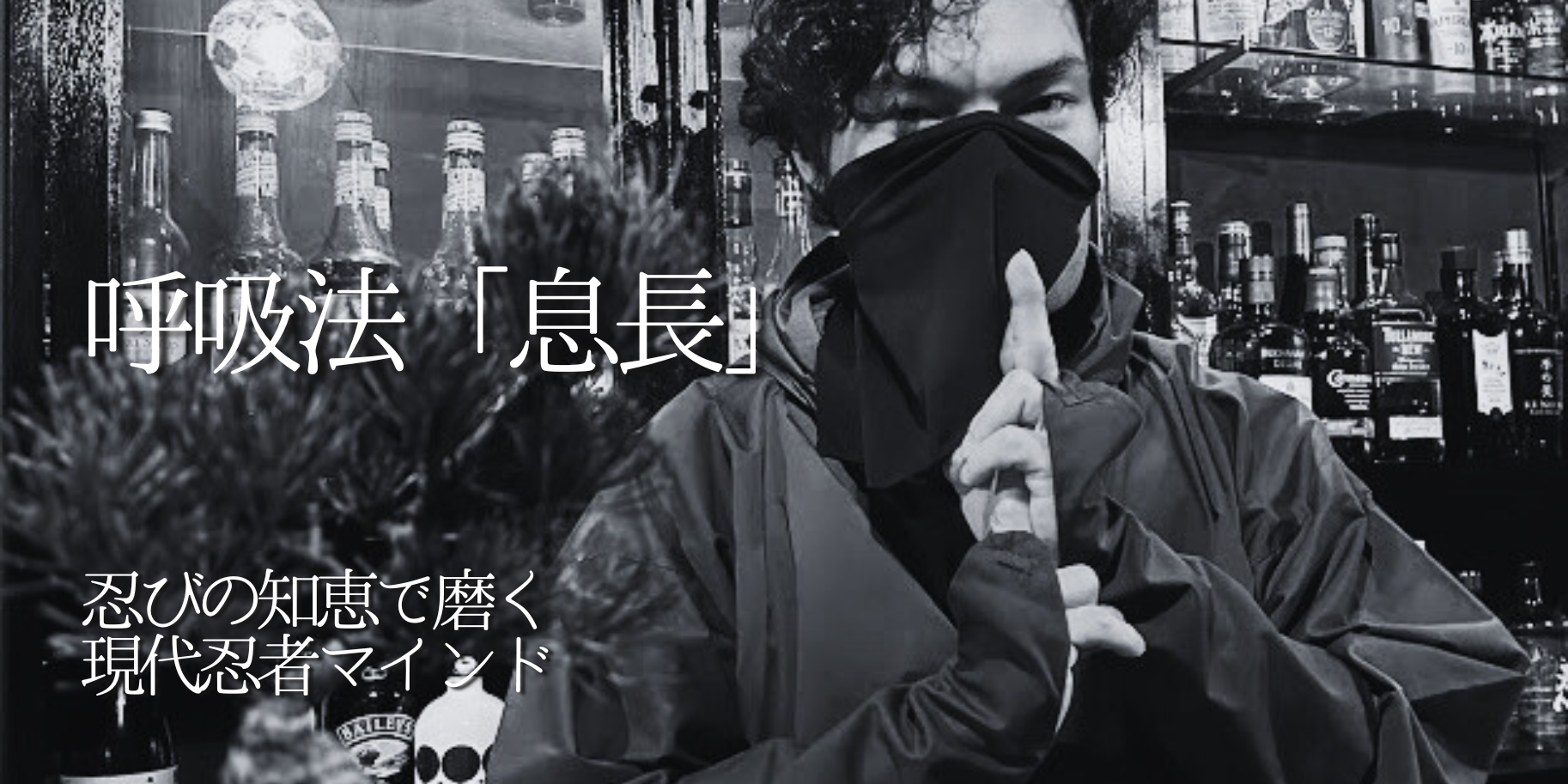忍びの知恵で磨く 現代忍者マインド:呼吸法「息長」
息長の術とは
「息長(おきなが)」とは、古来より忍者や修験道の行者たちが用いた特殊な呼吸法であり、長く穏やかな呼吸によって心身を整え、精神集中や体内エネルギーのコントロールを可能にする技法である。特に、敵に気配を悟られずに潜入する際や、極限状態での冷静さを保つために欠かせぬ術であったのじゃ。
一般の者には60秒以上も呼気を続けるなど到底不可能に思えるが、これは単なる呼吸の技術ではなく、身体操作術と精神統一の鍛錬が深く関わっておる。忍者たちは、身体の無駄な力を抜き、丹田に意識を集中させることで、酸素消費を最小限に抑え、驚異的な持久力を発揮しておったのじゃ。
息長の具体的なやり方
- 姿勢を整える
静かな場所で、背筋を伸ばし、安定した姿勢を取る。あぐらや正座が理想じゃが、椅子に座ってもよい。重要なのは、肩の力を抜き、体の緊張を解くことじゃ。 - 腹式呼吸を意識する
鼻からゆっくりと息を吸い込み、空気を下腹(丹田)に溜める感覚を持つ。4~5秒かけて深く吸い込むのが理想じゃ。 - 一瞬息を止める
息を吸いきったら、1〜2秒ほど息を止める。これにより、酸素が体内にしっかり行き渡るのじゃ。 - 細く長く吐き出す
口を軽く開き、「ふぅー」と音を立てるように、できるだけ細く長く息を吐く。最初は20秒ほどを目標にし、徐々に30秒、40秒と延ばしていく。最終的には60秒を目指すが、無理は禁物じゃ。 - 繰り返し鍛錬する
1セット5〜10回を目安に、毎日続けることが重要じゃ。慣れてきたら、瞑想と組み合わせることで精神統一の効果も高まる。
なぜ忍者は「息長」を習得する必要があったのか?
忍者にとって「息長」は単なる呼吸法ではなく、生死を分ける重要な術であった。
例えば、敵の屋敷に潜入し、身を潜めて気配を消す時、浅く速い呼吸では心拍数が上がり、敵に気配を察知されてしまう。そこで「息長」によって心拍を下げ、体温も下げることで、まるで死体のように静かに存在を消していたのじゃ。
また、修験者や山伏も、厳しい山岳修行の中で「息長」を用いて精神を安定させ、体内のエネルギー(気)を高めることで、極限の環境でも動じない強靭な精神力を養ったのじゃ。これこそが、現代でいう「マインドフルネス」や「瞑想」に通じるものである。
現代への応用
現代社会でも、ストレス管理や集中力向上のために「息長」を活用することができる。特にビジネスの場面やスポーツにおいて、パフォーマンスを向上させる効果が期待できるのじゃ。
1. ストレス解消とリラックス効果
深い呼吸によって副交感神経を活性化させ、心身の緊張を解くことができる。仕事の合間や寝る前に「息長」を行うことで、質の高い休息が得られるのじゃ。
2. 集中力向上
呼吸を整えることで心が落ち着き、集中力が高まる。特にプレゼンや試験前など、緊張する場面で実践すると、心拍が安定し、冷静に状況を見極める力が養われる。
3. 忍耐力と持久力の強化
長時間の作業やスポーツにおいて、息長を用いることで酸素の供給を効率化し、持久力を向上させることができる。これにより、疲れにくく、安定したパフォーマンスが可能となる。
忍者の「息長」を現代に取り入れる意義
現代社会では、情報の洪水や過密なスケジュールによって、心身が常に緊張状態にある者も多い。しかし、忍者の「息長」を実践することで、自分の内側に意識を向け、心の静寂を取り戻すことができるのじゃ。
例えば、岡山の忍者隊「葉隠」でも、演武前に「息長」を実践し、集中力と精神統一を高めておる。これは、まさに現代に生きる「本物の忍者マインド」と言えよう。
まとめ
- 「息長」は、忍者や修験者が用いた長く穏やかな呼吸法
- 腹式呼吸と精神統一を組み合わせ、心拍数や体温をコントロールする技術
- 現代ではストレス解消や集中力向上、持久力強化に応用可能
「忍びの知恵で磨く 現代忍者マインド」として、まずは1日5分でも「息長」を取り入れてみてはいかがかな?
静かに己と向き合い、内なる力を養うことで、あなたも現代に生きる「忍者」へと近づくであろう。
【以下英語版】【English version below】
Sharpen Your Modern Ninja Mind with the Art of “Okinaga” Breathing
What is the Art of “Okinaga”?
“Okinaga” (息長), meaning “long breath,” is an ancient breathing technique practiced by ninjas and ascetic monks of Shugendo. Through slow, deep breathing, they were able to calm the mind and body, enhance concentration, and control internal energy. This technique was essential for staying hidden from enemies and maintaining composure in extreme situations.
For ordinary people, exhaling for over 60 seconds seems impossible. However, this ability was not merely about breathing but involved advanced body control and intense mental training. By releasing unnecessary tension and focusing on the lower abdomen (known as the “tanden”), ninjas could minimize oxygen consumption and achieve remarkable endurance.
The Step-by-Step Guide to “Okinaga” Breathing
1. Adjust Your Posture
Find a quiet place and sit with a straight spine. Sitting cross-legged or in the seiza (formal Japanese sitting position) is ideal, but sitting on a chair is also acceptable. The key is to relax your shoulders and release tension from your body.
2. Focus on Abdominal Breathing
Inhale slowly through your nose, imagining the air filling your lower abdomen (tanden). Aim to inhale over 4-5 seconds.
3. Pause for a Moment
After a full breath, hold your breath for 1-2 seconds. This allows the oxygen to circulate throughout your body.
4. Exhale Slowly and Thinly
Gently open your mouth and exhale with a soft “whooo” sound. Try to make the exhalation as long and thin as possible. Start with 20 seconds and gradually extend to 30, 40, and ultimately 60 seconds. However, avoid overexerting yourself.
5. Practice Consistently
Aim for 5 to 10 sets per session and practice daily. Over time, combining this with meditation will further enhance your mental focus and energy control.
Why Did Ninjas Need to Master “Okinaga”?
For ninjas, “Okinaga” was not merely a breathing technique but a life-or-death skill.
When infiltrating enemy territory or hiding in the shadows, shallow and rapid breathing would raise their heart rate, making them detectable. By mastering “Okinaga,” they could lower their heart rate and body temperature, effectively blending into their surroundings as if they were lifeless.
Moreover, ascetic monks and yamabushi (mountain priests) used this breathing method during rigorous mountain training to stabilize their minds and enhance internal energy flow (ki), allowing them to remain calm in extreme environments. This practice closely resembles modern mindfulness and meditation techniques.
Modern Applications of “Okinaga” Breathing
In today’s world, “Okinaga” breathing can be a powerful tool for stress management, concentration enhancement, and performance improvement in various fields, from business to sports.
1. Stress Relief and Relaxation
Deep breathing activates the parasympathetic nervous system, relieving tension and promoting relaxation. Practicing “Okinaga” before bed or during work breaks can improve sleep quality and reduce anxiety.
2. Enhanced Focus and Mental Clarity
Controlling your breath calms the mind and sharpens concentration. It is especially effective before presentations or exams, allowing you to maintain composure and make sound decisions.
3. Increased Endurance and Stamina
By efficiently supplying oxygen to your body, “Okinaga” breathing enhances endurance and prevents fatigue during long work sessions or athletic performance.
The Significance of Adopting “Okinaga” in Modern Life
In today’s fast-paced world filled with information overload and constant stress, many people struggle with mental and physical tension. By incorporating the ancient ninja breathing technique of “Okinaga,” you can regain inner peace and cultivate strength from within.
For instance, the Okayama Ninja Team “Hagakure” practices “Okinaga” before performances to sharpen their focus and achieve mental unity. This embodies the true “Modern Ninja Mind.”
Conclusion
- “Okinaga” is an ancient breathing technique used by ninjas and ascetic monks to control their heart rate and mental state.
- By combining abdominal breathing and mental focus, it enables deep relaxation and enhances performance.
- In modern life, it can be applied to stress management, concentration improvement, and endurance training.
As part of the “Sharpen Your Modern Ninja Mind” series, why not start practicing “Okinaga” for just five minutes a day? By quietly facing yourself and strengthening your inner energy, you too can embody the true spirit of the modern ninja.



